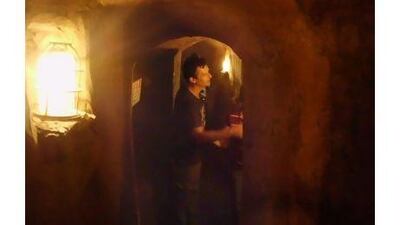JIAOZHUANGHU // Jiaozhuanghu village, 60 kilometres from downtown Beijing, stands out as an exception amid the array of bland villages outside the capital.
Underneath the ground is a vast network of tunnels built by hand to help repel Japanese forces. The warren of linked passageways, little known outside China, has even been dubbed "the Underground Great Wall".
Work on the tunnels began in 1943 and initially they were made up of just a small stretch with space for a few people. The tunnels were said to have been built under the direction of the local communist party.
"Back then, they didn't have much choice but to hand-dig the tunnels. You can imagine how painstaking this work was and how much time it took to build the tunnels," said a tour guide.
"Most of the people were just farmers. In many cases it was just ordinary citizens [who fought the Japanese from the tunnels] if the Chinese military wasn't able to put up resistance."
Over the following years, a vast expansion was undertaken to the extent the tunnels are said to have eventually connected every home in the village, and stretched out to three neighbouring villages. The 11.5km complex included traps for Japanese troops, arms caches, concealed bunkers and command posts.
Tunnel entrances were often elaborately disguised by everything from pig sties to cupboards, stables and even trees. Command posts for snipers were built into everyday village items such as millstones used to grind corn.
The section of the tunnels open to the public is a tourist attraction with a small museum nearby, although it is a long way from the itineraries of most visitors to China.
Yet for Chinese people the tunnels remain a reminder of when Japanese forces occupied huge swathes of the country, particularly in the north-east, after invading in 1931, six years before the start of full-scale war.
Efforts such as the building of the tunnels represented China's often successful attempts to engage in guerrilla warfare against the Japanese.
Interpretations differ on the relative contributions of communist and nationalist forces in the fight against the Japanese during the Second Sino-Japanese War.
Most official histories overstate the communist contribution, said Xu Guoqi, a professor of history at the University of Hong Kong and author of books including China and the Great War, although he added that the communists "did actively get involved in guerrilla warfare".
"There was widespread guerrilla warfare involving Chinese villages, especially in northern China, to fight against the Japanese," he said.
"Chinese peasants provided crucial support for the communists in terms of shelter and food."
According to Marjorie Dryburgh, a lecturer in Chinese studies at the University of Sheffield in the United Kingdom, the official story is that this support was seen as a patriotic duty, and that villagers were compensated for everything they gave to Chinese forces.
She added however that the potential costs to villagers of supporting Chinese troops would have been "enormous" because of, for example, the risk of reprisals from the Japanese.
"I would suspect that there was sometimes more tension in that guerilla-villager relationship than is commonly said," she said.
The conflict ended in 1945, after which communist and nationalist forces fought one another until the latter fled to Taiwan in 1949, heralding the start of communist rule in China.
The tunnels are believed to be the only ones of their kind in Beijing Municipality, the area that encompasses the capital and much of the surrounding countryside, created to repel Japanese troops, although Beijing city has tunnels developed when tensions were high with the Soviet Union.
The 66th anniversary of the end of the Second Sino-Japanese War will be marked on September 9, and the tunnels are a reminder of this episode, which continues to arouse passions and to complicate Sino-Japanese relations.
"Almost all Chinese will develop strong anti-Japanese feelings and become quite nationalistic when visiting such sites," Mr Xu said of the tunnels.
The conflict represents the most "sensitive nerve" of China's 20th century history for young and old Chinese.
"Any touch of it will trigger strong responses," he said. "The war memory will forever define bilateral relations between China and Japan as long as both countries cannot put the wartime history behind them."
Ms Dryburgh added that the Chinese authorities put a lot of effort into keeping memories of the conflict alive through investments in memorials and museums, by marking anniversaries and funding academic research.
There is, she said, a "pervasive sense that Japan has not fully acknowledged the extent of abuses and atrocities".


